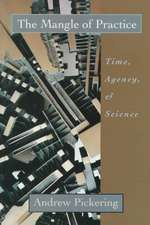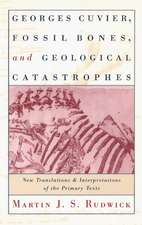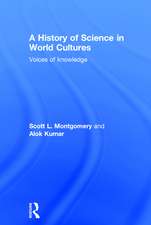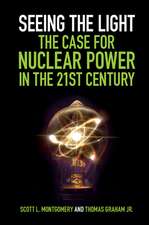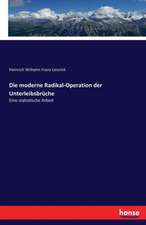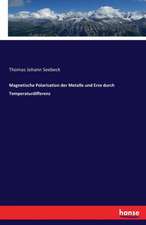The Chicago Guide to Communicating Science: Second Edition: Chicago Guides to Writing, Editing, and Publishing
Autor Scott L. Montgomeryen Limba Engleză Paperback – 21 feb 2017
For more than a decade, The Chicago Guide to Communicating Science has been the go-to reference for anyone who needs to write or speak about their research. Whether a student writing a thesis, a faculty member composing a grant proposal, or a public information officer crafting a press release, Scott Montgomery’s advice is perfectly adaptable to any scientific writer’s needs.
This new edition has been thoroughly revised to address crucial issues in the changing landscape of scientific communication, with an increased focus on those writers working in corporate settings, government, and nonprofit organizations as well as academia. Half a dozen new chapters tackle the evolving needs and paths of scientific writers. These sections address plagiarism and fraud, writing graduate theses, translating scientific material, communicating science to the public, and the increasing globalization of research.
The Chicago Guide to Communicating Science recognizes that writers come to the table with different needs and audiences. Through solid examples and concrete advice, Montgomery sets out to help scientists develop their own voice and become stronger communicators. He also teaches readers to think about their work in the larger context of communication about science, addressing the roles of media and the public in scientific attitudes as well as offering advice for those whose research concerns controversial issues such as climate change or emerging viruses.
More than ever, communicators need to be able to move seamlessly among platforms and styles. The Chicago Guide to Communicating Science’s comprehensive coverage means that scientists and researchers will be able to expertly connect with their audiences, no matter the medium.
This new edition has been thoroughly revised to address crucial issues in the changing landscape of scientific communication, with an increased focus on those writers working in corporate settings, government, and nonprofit organizations as well as academia. Half a dozen new chapters tackle the evolving needs and paths of scientific writers. These sections address plagiarism and fraud, writing graduate theses, translating scientific material, communicating science to the public, and the increasing globalization of research.
The Chicago Guide to Communicating Science recognizes that writers come to the table with different needs and audiences. Through solid examples and concrete advice, Montgomery sets out to help scientists develop their own voice and become stronger communicators. He also teaches readers to think about their work in the larger context of communication about science, addressing the roles of media and the public in scientific attitudes as well as offering advice for those whose research concerns controversial issues such as climate change or emerging viruses.
More than ever, communicators need to be able to move seamlessly among platforms and styles. The Chicago Guide to Communicating Science’s comprehensive coverage means that scientists and researchers will be able to expertly connect with their audiences, no matter the medium.
Din seria Chicago Guides to Writing, Editing, and Publishing
-
 Preț: 97.74 lei
Preț: 97.74 lei -
 Preț: 186.13 lei
Preț: 186.13 lei -
 Preț: 139.22 lei
Preț: 139.22 lei -
 Preț: 120.87 lei
Preț: 120.87 lei -
 Preț: 103.49 lei
Preț: 103.49 lei -
 Preț: 108.27 lei
Preț: 108.27 lei -
 Preț: 115.67 lei
Preț: 115.67 lei -
 Preț: 132.51 lei
Preț: 132.51 lei -
 Preț: 305.98 lei
Preț: 305.98 lei -
 Preț: 134.26 lei
Preț: 134.26 lei -
 Preț: 147.49 lei
Preț: 147.49 lei -
 Preț: 107.91 lei
Preț: 107.91 lei -
 Preț: 106.01 lei
Preț: 106.01 lei -
 Preț: 114.48 lei
Preț: 114.48 lei -
 Preț: 210.01 lei
Preț: 210.01 lei -
 Preț: 148.03 lei
Preț: 148.03 lei -
 Preț: 158.19 lei
Preț: 158.19 lei -
 Preț: 133.32 lei
Preț: 133.32 lei -
 Preț: 116.15 lei
Preț: 116.15 lei -
 Preț: 194.53 lei
Preț: 194.53 lei -
 Preț: 157.15 lei
Preț: 157.15 lei -
 Preț: 139.84 lei
Preț: 139.84 lei -
 Preț: 99.83 lei
Preț: 99.83 lei -
 Preț: 91.96 lei
Preț: 91.96 lei -
 Preț: 147.26 lei
Preț: 147.26 lei -
 Preț: 107.66 lei
Preț: 107.66 lei -
 Preț: 139.72 lei
Preț: 139.72 lei -
 Preț: 99.60 lei
Preț: 99.60 lei -
 Preț: 124.16 lei
Preț: 124.16 lei -
 Preț: 122.50 lei
Preț: 122.50 lei -
 Preț: 192.95 lei
Preț: 192.95 lei -
 Preț: 82.29 lei
Preț: 82.29 lei -
 Preț: 122.59 lei
Preț: 122.59 lei -
 Preț: 100.37 lei
Preț: 100.37 lei -
 Preț: 105.29 lei
Preț: 105.29 lei -
 Preț: 147.40 lei
Preț: 147.40 lei -
 Preț: 149.63 lei
Preț: 149.63 lei -
 Preț: 148.39 lei
Preț: 148.39 lei -
 Preț: 115.71 lei
Preț: 115.71 lei -
 Preț: 407.90 lei
Preț: 407.90 lei -
 Preț: 187.79 lei
Preț: 187.79 lei -
 Preț: 234.64 lei
Preț: 234.64 lei -
 Preț: 237.81 lei
Preț: 237.81 lei -
 Preț: 144.94 lei
Preț: 144.94 lei
Preț: 225.69 lei
Nou
Puncte Express: 339
Preț estimativ în valută:
43.20€ • 44.52$ • 36.47£
43.20€ • 44.52$ • 36.47£
Carte tipărită la comandă
Livrare economică 01-15 martie
Livrare express 25-31 ianuarie pentru 68.38 lei
Preluare comenzi: 021 569.72.76
Specificații
ISBN-13: 9780226144504
ISBN-10: 022614450X
Pagini: 312
Ilustrații: 19 line drawings
Dimensiuni: 152 x 229 x 25 mm
Greutate: 0.53 kg
Ediția:Second Edition
Editura: University of Chicago Press
Colecția University of Chicago Press
Seria Chicago Guides to Writing, Editing, and Publishing
ISBN-10: 022614450X
Pagini: 312
Ilustrații: 19 line drawings
Dimensiuni: 152 x 229 x 25 mm
Greutate: 0.53 kg
Ediția:Second Edition
Editura: University of Chicago Press
Colecția University of Chicago Press
Seria Chicago Guides to Writing, Editing, and Publishing
Notă biografică
Scott L. Montgomery is an affiliate faculty member in the Henry M. Jackson School of International Studies at the University of Washington. He is the author or coauthor of numerous books, most recently The Shape of the New: Four Big Ideas and How They Made the Modern World and Does Science Need a Global Language? English and the Future of Research, the latter published by the University of Chicago Press. He lives in Seattle.
Cuprins
Preface to the Second Edition
Preface to the First Edition
Part 1. The Language and Rhetoric of Science: Using Them to Your Advantage
1. Communicating Science
2. The Language of Science: Historical Realities for Readers and Writers
3. Reading Well: The First Step to Writing Well
4. Writing Well: A Few Basics
5. Writing Very Well: Opportunities for Creativity and Elegance
6. The Review Process: Dealing with Contents and Discontents
7. Through a Flask Darkly: Plagiarism, Fraud, and the Ethics of Authorship
Part 2. Communicating Professionally: Where, What, and How
8. Professional Scientific Communication: Where Does It Happen?
9. The Scientific Paper: A Realistic View and Practical Advice
10. Other Types of Writing: Review Articles, Book Reviews, Debate/Critique
11. The Proposal
12. Graphics and Their Place
13. Oral Presentations: A Few Words
14. The Graduate Thesis (Dissertation): What It Means and How to Do It
15. The Online World: Science in a New Context
Part 3. Special Topics in Communicating Science
16. For Researchers with English as a Foreign Language
17. Translating Scientific Material: Guiding Principles and Realities
18. Meet the Press: How to Be an Effective and Responsible Source for the Media
19. Science Writing and Science Talks: Communicating with and for the Public
20. Teaching Science Communication: Helpful Ideas for the Classroom
21. In Conclusion
Selected Bibliography
Index
Preface to the First Edition
Part 1. The Language and Rhetoric of Science: Using Them to Your Advantage
1. Communicating Science
2. The Language of Science: Historical Realities for Readers and Writers
3. Reading Well: The First Step to Writing Well
4. Writing Well: A Few Basics
5. Writing Very Well: Opportunities for Creativity and Elegance
6. The Review Process: Dealing with Contents and Discontents
7. Through a Flask Darkly: Plagiarism, Fraud, and the Ethics of Authorship
Part 2. Communicating Professionally: Where, What, and How
8. Professional Scientific Communication: Where Does It Happen?
9. The Scientific Paper: A Realistic View and Practical Advice
10. Other Types of Writing: Review Articles, Book Reviews, Debate/Critique
11. The Proposal
12. Graphics and Their Place
13. Oral Presentations: A Few Words
14. The Graduate Thesis (Dissertation): What It Means and How to Do It
15. The Online World: Science in a New Context
Part 3. Special Topics in Communicating Science
16. For Researchers with English as a Foreign Language
17. Translating Scientific Material: Guiding Principles and Realities
18. Meet the Press: How to Be an Effective and Responsible Source for the Media
19. Science Writing and Science Talks: Communicating with and for the Public
20. Teaching Science Communication: Helpful Ideas for the Classroom
21. In Conclusion
Selected Bibliography
Index
Recenzii
“Enhanced with approximately 100 additional pages, this second edition is a testament to the success of the first one. . . . Montgomery emphasizes reaching nontechnical audiences and characterizes clear and compelling communications as ‘required forms of professional competence.’”
“Montgomery again provides accessible, actionable advice that will help researchers excel at the fundamentals of their craft, from writing and reviewing scientific manuscripts to drafting compelling grant proposals and to delivering engaging oral presentations. However, it is in the second edition’s newest material that the book truly shines. The author’s exploration of new topics such as teaching science communication, communicating science to public audiences, science translation, and online communication necessarily address the increased dynamism of the modern communication ecosystem for science.”
“Montgomery wants scientists to cast off the straitjacket of convention when they write for other scientists, or at least to ask a friend to loosen the ties. He covers a huge amount of ground, from papers and review articles to book reviews, presentations, and online publishing. He has some excellent practical advice for nervous publishing virgins with writer’s block as well as encouragement for more experienced writers flirting coyly with metaphor and the occasional rhetorical flourish.”
“Montgomery acknowledges that the training of scientists, unlike higher education in the humanities, has long excluded the formal development of writing, oral presentation, and editing. But he sets out to dispel the notion that scientists are inherently less skilled at the art of communication. . . . Armed with a little more knowledge of basic tenets of writing, he says, any scientist can write with eloquence.”
"That the author excels at demystifying the language of science will surprise no one who is familiar with the original edition. Montgomery again provides accessible, actionable advice that will help researchers excel at the fundamentals of their craft, from writing and reviewing scientific manuscripts to drafting compelling grant proposals and to delivering engaging oral presentations. However, it is in the second edition's newest material that the book truly shines. The author's exploration of new topics such as teaching science communication, communicating science to public audiences, science translation, and online communication necessarily address the increased dynamism of the modern communication ecosystem for science."


